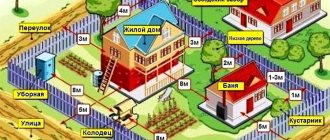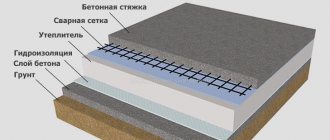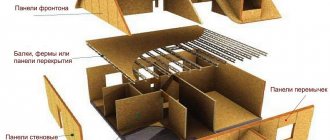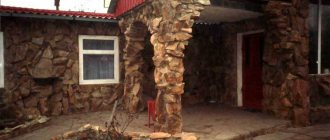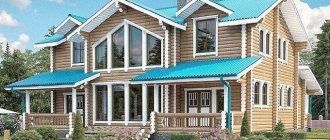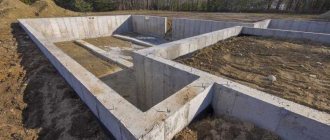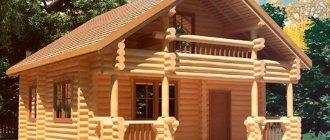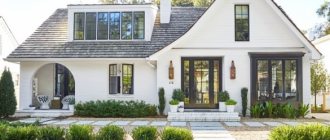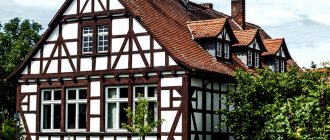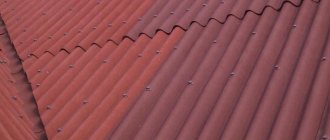The construction of brick houses has a long history. All over the world, tens, and maybe hundreds of thousands of brick structures have been erected, the age of which is more than 100-150 years. Today, new types of building materials continue to appear and disappear, but brick still remains the main building material in the world. In this article we will analyze the main advantages of brick, thanks to which it is so popular in the construction of cottages and multi-storey buildings. Among the many advantages of brick, we decided to focus on only the seven main ones, because of which most people choose brick to build their homes - strength, durability, environmental friendliness, frost resistance, aesthetics and versatility of use, fire safety and noise insulation features.
Strength
The strength of brick is one of the most important characteristics of this building material. For most people who want to build a truly durable house, brick is the only suitable building material, primarily because of its high strength. This is the main feature of this building material, which must be taken into account when building a brick house. The strength of a brick is expressed by its branding and is designated by the letter “M”, followed by the strength value in numbers. The numbers after the letter show the load in kilograms per 1 sq.cm. able to withstand brick. For example, the M125 brand means that this type of brick is guaranteed to withstand a load of 125 kg per 1 sq.cm. In contrast to foam and aerated concrete blocks of the M25-50 grade, for the construction of a brick cottage up to three floors high, it is enough to choose a brick of the M100 grade. Such brick walls are strong and dense enough to be able to hang a TV or large bookshelf on them. In the construction of multi-storey brick houses, brick of a grade not lower than M150 is used. Bricks of the M100, M125, M150, M175 brands are usually available for sale. But there are also especially strong bricks of grade M200 and more. The record holder of the Republic of Bashkortostan in the production of durable building bricks is the Bashkir Brick holding, whose factories produced the most durable building bricks in the republic of the M250 and M300 brands for 2 years in a row.
Material characteristics
Brick is a piece of building material of regular shape, pressed from mineral raw materials.
Due to its high strength and water resistance, it is defined as artificial stone and is used in the construction of walls and other architectural elements.
Advantages and disadvantages
Brick and houses made from it have the following advantages:
- high mechanical strength, the possibility of constructing multi-storey buildings;
- good thermal insulation abilities (thermal conductivity coefficient - 0.3-0.7 W/mhdeg);
- the presence of micropores, providing a “breathing effect”;
- durability, because houses can be built even from old bricks;
- high frost resistance;
- incombustibility and fire resistance of special varieties;
- harmonious combination with other materials (wood, metal, etc.);
- the ability to create various decor options.
Brick construction also has some disadvantages:
- increased labor intensity of masonry due to the small size of individual bricks;
- high construction costs and the cost of the material itself;
- significant weight, causing increased requirements for the foundation;
- seasonality of construction due to the presence of “wet” technology.
The main advantage of brick houses is their high durability. Service life exceeds 100 years. Practice shows that brick structures can last for several centuries.
Varieties
Building bricks are classified according to manufacturing technology and raw materials used, according to volume filling, size and purpose.
Based on the raw materials used and manufacturing method, the following types of bricks are distinguished:
- ceramic - firing clay of different colors;
- clinker - sintering refractory clay at high temperature;
- silicate – heat treatment of a mixture of lime and sand with additives;
- acid-resistant – made of special clay that is resistant to acids;
- fireclay - made of fireproof clay;
- semi-dry pressing - incomplete firing cycle or drying of clay;
- ceramite – sintering of silicon sand.
Based on volume filling, bricks are divided into 2 types:
- Full-bodied. The voids in the brick do not exceed 13%, and the density is at least 1600 kg/m3.
- Hollow. Through or limited voids (holes) are formed in the bricks. They can occupy up to 45% of the total volume. The density of such elements does not exceed 1400 kg/m3.
The first option has high mechanical strength, and the voids provide increased heat and sound insulation properties.
According to their purpose, bricks are divided into ordinary (masonry, construction), facing and special . The first type is intended for laying walls and other architectural elements that are subject to significant loads.
Facing bricks are designed to improve the heat and sound insulation parameters of a house and external decoration. It is not designed for significant loads and is divided into fireplace, facade and shaped varieties. It can have a different type of surface (smooth, embossed, glazed, etc.).
Special bricks (refractory, acid-resistant, clinker) are designed for special operating conditions.
Bricks are available in different sizes . According to this indicator, they are divided into standard (single), one-and-a-half (thickened) and double. The standard size is 250x120x65 mm.
In addition, Euro-size bricks (0.7 standard sizes) and modular varieties (1.3 from the standard), as well as partial-size elements (0.5, 0.33 and 0.25 from standard sizes) are used.
Which one is better to choose?
Bricks for building a house are selected according to type, size and purpose. The following main characteristics must be taken into account:
- coefficient of thermal conductivity,
- mechanical strength,
- water absorption,
- frost resistance,
- resistance to sudden temperature changes, i.e. to freeze-thaw cycles (for example, the M50 brand indicates that the brick can withstand at least 50 such cycles).
The most common is standard, solid ceramic brick, which is suitable for any masonry. If it is necessary to reduce the load on the foundation and increase thermal insulation parameters, use the hollow type.
Other varieties are used as follows:
Silicate
It has reduced water resistance and can decompose when heated . Frost resistance does not exceed minus 35°C. Maximum grade M150. It is recommended to use it for partitions and not very critical structures.
Zabutovochny
In fact, this is an ordinary red ceramic brick, which has lower requirements for appearance. As a result, it may have chips, deviations from the straightness of the edges, uneven color and other defects.
In terms of its properties, the material is close to its high-quality “brother”; its use in masonry facades is limited only by aesthetics. Brick is sold in solid and hollow versions, with different sizes. The most common sizes: 250x120x88 and 250x125x65 mm .
If you apply plaster and other finishing on top of the masonry, then “backfilling” can be used for any walls. The main advantage is low price. The main disadvantage is the difficulty in laying due to fluctuations in size and uneven surfaces.
Clinker
It is baked at a very high temperature, which provides increased strength and frost resistance. It practically does not absorb water. Brick can be used for houses operating in very difficult conditions. The main limitation is the increased price .
"Lego"
This brick has a specific shape, reminiscent of the children's construction set of the same name. Each element has holes, at the edges of which there is a profile that allows the bricks to be tightly joined together. In manufacturing, hyperpressing technology is used, which ensures high strength.
Using this material you can lay load-bearing walls and partitions . It is not suitable for harsh conditions because... withstands about 35 cycles. An important condition is that the masonry is provided with a special glue, which makes it possible to reduce the seam.
Facing
It can be used for external decoration of walls and foundations. It can play a protective (thermal insulation, reduced water absorption, increased light resistance, etc.) or decorative role. Brick comes in different shapes and colors.
Different surface textures allow you to provide the desired design . Widely used for finishing facades, fireplaces and other elements of the house.
Double
It is distinguished by its increased size - 250x120x140 mm. The material is used for laying load-bearing walls and structural elements of considerable thickness.
The increased size allows for increased construction productivity, and the hyper-pressing technology during manufacturing provides increased mechanical strength. It is important to consider that the weight of such a brick is 4.7-5 kg, which increases the load on the foundation.
The choice of brick depends on the requirements for masonry, the purpose of the house and financial capabilities, as well as climatic conditions and terrain.
Color selection (red, yellow, white, brown)
Brick can have different colors and shades from light to dark . The color scheme depends on the composition of the clay and the use of special additives.
Features of using bricks:
- Yellow. This type of brick is usually used for wall cladding and provides an original, bright appearance.
- Brown. This noble shade looks presentable. Elite houses are made from such facing bricks.
- White. Along with red, white is very popular. It is most characteristic of sand-lime brick.
- Red. This is a traditional brick color produced by firing quality clay. This brick is used for any masonry.
It is important to understand that color does not affect the properties of the brick, which are determined by the composition and manufacturing technology, so you can build a house from any colored brick. The choice of color scheme depends solely on the preferences of the owner of the house and the design style.
Durability
Brick cottages are considered one of the most durable buildings in the world.
A properly built brick house can last 100-150 years without repairing the facade. These data are also confirmed by official GOST standards. But the most important proof of the durability of brick buildings are the numerous buildings and structures made of brick, which are several hundred years old! Apart from brick, no modern building material can boast of such longevity. For those who plan to build a house that will serve their grandchildren and great-grandchildren, brick is the best solution. Durable, comfortable, reliable - a brick house embodies the best ideas about a family estate, capable of preserving family values and traditions for centuries. Brick houses are resistant to almost all external natural factors. Brick walls withstand frost, rain, heat and are able to withstand the destructive effects of other atmospheric and biological factors. It is for this reason that the expression “My home is my fortress” is more suitable than ever for brick houses, which embody the embodiment of reliability, durability, comfort and safety.
Environmental friendliness
Brick is made from clay, sand and water.
This brick is a natural and environmentally friendly material that does not contain substances harmful to humans. And thanks to its structure, brick is able to allow air to pass through well. It is for this reason that brick is called a “breathing” material. Also, brick is not subject to rotting processes, and it is not afraid of any pests. This differs from wood, which is also an environmentally friendly material, but to protect it from mold and rot it must be treated with chemical solutions, which leads to the loss of the original environmentally friendly properties of wood. Brick walls regulate the air humidity in the house, thereby creating comfortable conditions for people indoors. This sets it apart from concrete, which is a moisture-retaining material. These features of the brick help create a favorable microclimate inside the house at any time of the year. In rain, snow or windy weather, a brick house will always be dry and warm, and humidity will be evenly distributed throughout the room. Because of these properties, brick multi-storey buildings have always been preferable to their panel counterparts.
Formwork and redevelopment
Due to the fact that the walls in a monolithic brick house have columns in the form of supports, apartments in such buildings can be redeveloped. Moreover, you can choose any option that you like, make arches, openings in the walls, etc. But it is necessary to remember some rules that must be followed in order for the planning to be completely legal in the future. They are as follows:
- It is prohibited to dismantle walls, beams, load-bearing supports, and ventilation. Wiring and gas pipes, risers from a centralized heating system must not be walled into the walls.
- If you need to change the gasification system or water supply, you need to contact special services. It is prohibited to carry out such work yourself.
- It is prohibited to place a bathroom above the neighbors’ living space and kitchen.
- Fire-fighting devices must not be removed.
- If you need to redesign a kitchen, bathroom or bathroom, then everything should first be agreed upon with the neighbors.
- The area of living rooms must be at least 9 square meters. m, and the width of the room must be at least 2 m and 25 cm. Heating system radiators and windows must be present.
- It is forbidden to increase the territory of the utility room at the expense of living rooms, but you can make a larger corridor.
For the construction of a monolithic brick house, 2 formwork options are used. First of all, it's removable. It can be used many times. Secondly, it is not removable. It is only disposable. As for the latter, this one is perfect for the construction of one-story buildings. For houses with several floors, this option is permitted, but scaffolding is used. To create such formwork, walls are made of hollow slabs. For this, a wood-cement composition or polystyrene foam is used. The slabs or composition are attached using metal ties. All that remains is to pour the concrete solution into the space between the slabs and wait until it hardens. As a result, the wall will include 3 layers. Thanks to this, it has excellent thermal insulation and sound insulation properties. In addition, facades can be additionally insulated with mineral wool or expanded polystyrene. It is recommended to use ties that have a coating with anti-corrosion properties.
Frost resistance
In conditions of the not very mild Russian climate, one of the main factors when choosing a material for building a cottage or house is the frost resistance of the building material.
The more frost-resistant the material, the more durable the house itself will be. Frost resistance is the ability of a building material to withstand freezing and thawing in a water-saturated state. It is marked with the letter F, indicating the number of freezing and thawing cycles. The optimal number of cycles for the central regions of Russia is F35/F50. Brick has high frost resistance, which is confirmed not only by tests, but also by many years of experience in its use in construction.
Aesthetics and versatility of use
Brick is perhaps the most favorite material of architects.
In addition to its high functional features, such as strength, durability and environmental friendliness, brick, as a building material, allows you to experiment and create unique projects tailored to the most unusual requirements and desires of the customer. The small size of the brick and masonry technology allow architects to use a variety of solutions in the design of brick cottages. When choosing bricks for building a cottage, you can build as many floors as you like, choose any arrangement of rooms, plan any façade design. The house can be built in any architectural style, and the variety and originality of forms will give the house its own unique look. The brick walls of a house can be subjected to a variety of types of finishing. Brick also combines well with other types of building materials, and the simple technology of building a brick house allows you to implement various design solutions. Among other things, the construction of brick houses is widespread in our area also because the technologies for constructing brick houses and cottages have already been well developed, and finding good craftsmen to implement the project is not particularly difficult.
Finishing an apartment in a brick house
Buildings made from this material have the longest shrinkage period. For older houses this is not a problem. But when buying an apartment in a new building, you shouldn’t be surprised at the warping of the wall that occurs 5 years after commissioning. So it’s worth holding off on major repairs.
The surface of brick walls is usually uneven, requiring serious rough finishing. Since too much plaster may be required, it is more rational to level the walls with plasterboard.
At the same time, a brick wall is an attractive decorative element. In interior styles such as loft, it is welcome. It is enough just to cover the surface with varnish and not think about plaster, putty and wallpaper.
And next time we will talk about monolithic houses.
Fire safety
The ability to withstand high temperatures is one of the main features of brick, which distinguishes it favorably in the building materials market.
Brick is a fire-resistant material, it ideally complies with fire safety standards, and since brick walls do not support combustion, the possibility of a fire in a brick house is minimized, unlike wooden and frame houses. In emergency situations, this circumstance can increase the chances of the fire brigade arriving on time and saving the house. Even if the building burns completely, the brick walls will remain intact, despite the fact that in severe fires the brick frame of the house may lose its strength. But in any case, the fact remains that the brick is able to withstand strong fire, which is an undoubted advantage of the brick.
Noise insulation
In addition to all the listed advantages of brick, it is also worth noting that brick walls provide reliable sound insulation in the house.
Brick walls are an excellent sound barrier. Comparing sound insulation among panel and wooden houses, in brick houses it will be at the highest level. Brick is the only modern building material that has been tested by time. Brick houses stand for centuries without losing their functional features, such as durability and strength, and their appearance does not lose its aesthetic appearance for centuries. Perhaps it is for this reason that many brick houses become real family nests, passed on from generation to generation.
The secret of brick lies, first of all, in its ease of production and its unpretentiousness in construction. Possessing a number of serious advantages, brick has firmly established its status as a reliable and universal building material. That is why, whether it is a large mansion or a small house, brick is the ideal material for building durable and reliable housing.
Disadvantages of building a brick house
- High price . Brick is more expensive than wood and frame technology. The difference depends on the manufacturing format and block size.
- A reinforced foundation is needed . The stone weighs a lot. If a light strip foundation is enough for a wooden house, then you cannot do without a powerful slab or a pile-grillage foundation.
- Mandatory finishing . Outside - cladding, decorative plaster, inside - plaster, putty, and other layers of finishing. For comparison, it is enough to paint a wall made of laminated timber. Options for finishing the facade of combined houses
- Low thermal insulation . If you use ordinary brick, you will have to install insulation - an additional layer of mineral wool.
- It takes a lot of time to build . Even large-format blocks are installed more slowly than laying timber.
- More labor-intensive finishing . Cladding facades and interior walls takes longer than finishing a wooden house.
- It is difficult to find bricks of the required quality. There are well-known manufacturers, but there are also many small companies that produce low-quality products. Therefore, we always work with one manufacturer and only directly.
Tour of a European brick factory
Brick is more expensive than wood and requires mandatory reinforcement of the foundation. But there will be even more disadvantages if you buy low-quality material.
